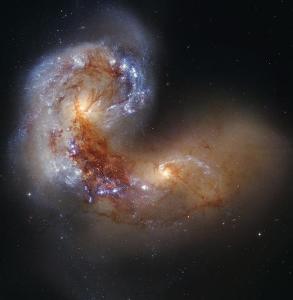Feb 5 2015
Researchers at the Universidad Politécnica de Madrid and the Instituto de Astrofísica de Canarias are studying the evolution and formation of hundreds of near galaxies and have just published new scientific images.
 NCG 4038/4039 galaxies. (Credits: NASA)
NCG 4038/4039 galaxies. (Credits: NASA)
Studying the internal structure and the interaction among galaxies has been the work carried out by researchers of Space Dynamics Group at UPM in collaboration with the Instituto de Astrofísica de Canarias (IAC). By combining the observational work with post-processing photos, researchers have successfully published new optical images of 1768 nearby galaxies. They have also developed the statistic analysis of their morphology and the interaction among galaxies from the data base of Spitzer Survey of Stellar Structure (S4G). This represents a step forward toward the comprehension of the universe origins.
Galaxies are made up of millions of stars and their structures depend on the evolving process in which they have been subjected, including interactions with other nearby galaxies. Galaxies are a key element on cosmology, since the understanding of their structure is an approach to the phenomena that govern the formation of the universe.
In order to make progress in this understanding, researchers at the School of Aeronautics and Space Engineering in collaboration with IAC have analyzed almost 3,000 nearby galaxies observed within the framework of Spitzer Survey of Stellar Structure (S4G), an exploration conducted by the Spitzer Space Telescope. The infrared images taken by Spitzer were complemented with optical images taken from other sources such as the Sloan Digital Sky Survey (Apache Point Observatory, Nuevo México, USA) and the Liverpool Telescope at the Observatorio de Roque de los Muchachos in La Palma (Spain).
These optical images have been properly reprocessed during this project and were made available to the entire scientist community. Thanks to this new image collection, researchers have completed two-thirds of the S4G.
Based on these images, researchers have carried out a statistical study of the morphology, composition and interaction among the galaxies.
The presence of a nearby galaxy can distort the morphology of other galaxy due to gravitational phenomena. A visual inspection is not enough to determine whether two galaxies are close because it is needed to take into account the magnitude and relative speed between them. Within the framework of this project, the processed images have been contrasted with the physical data from the NASA/IPAC Extragalactic Database (NED). Therefore researchers can establish objective and measurable criteria to verify whether two galaxies are indeed close.
As a result of this study, it is estimated that nearly the 17% of the observed galaxies are close neighbors and the 3% of the galaxies show important signs of interaction. Besides, they found that 32 galaxies show evidence of being merging with their neighbors. Lastly, they established diverse categories to set the interaction level among neighboring galaxies.